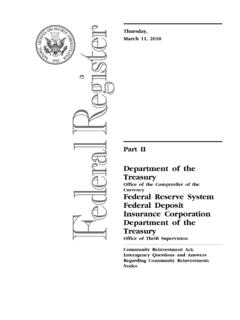Transcription of Frequently Asked Questions and Answers - CMS
1 1 Frequently Asked Questions for Hospitals and Critical Access Hospitals regarding EMTALA DATE: April 30, 2020 PATIENT PRESENTATION TO THE EMERGENCY DEPARTMENT : Has CMS provided guidance to patients on when it is appropriate to come to theEmergency Department for COVID-19 symptoms?A: The Centers for Disease Control and Prevention (CDC) has provided guidance for thegeneral public on steps individuals should take in regard to treatment when they believethey have symptoms of COVID-19 ( ). The CDC guidance is available in several languagesincluding Spanish, Chinese (simplified), Vietnamese and will continue to share CDC materials to address concerns about the appropriatemethods for seeking COVID-19 testing and treatment. These guidance documents areupdated as new guidance becomes : May hospitals place a sign outside an Emergency Department (ED) stating"COVID-19 testing is not being offered to asymptomatic patients?"A: Yes. In general, signage may be used to inform individuals about the availability ofCOVID-19 testing or to provide direction to alternative sites on the hospital s campuswhere medical screening examinations (MSE) are available; for example, directing thepatient to a parking lot test site for also may encourage the public to go to off-campus sites to be screened forCOVID-19 instead of the hospital.
2 Normally, a hospital may not tell individuals whohave already entered an ED to go to the off-site location for the MSE such a redirectionusually only occurs to an on-campus alternative site. However, CMS has approved via asection 1135 waiver for the COVID-19 public health emergency (PHE) the ability to re-direct patients to an offsite location for screening, in accordance with a state emergencypreparedness or pandemic emphasize that it is a violation of EMTALA for hospitals and critical access hospitals(CAHs) with EDs to use signage that presents barriers to individuals, including those whoare suspected of having COVID-19, from coming to the ED, or to otherwise refuse toprovide an appropriate MSE to anyone who has come to the ED for examination ortreatment of a medical : Are individuals (who present on a hospital campus or ED) that are referred to analternative off-campus screening site limited strictly to those individuals withCOVID-19 symptoms? For example, can an individual with an ankle injury be2 referred off-campus?
3 Can ambulance patients be referred off-campus ( without off-loading or any evaluation before being referred)? A: Yes. Redirection to another location (offsite alternate screening location) to receive a medical screening exam is allowed via a section 1135 waiver under a state emergency preparedness or pandemic plan regardless of the presence of COVID-19 symptoms. Public health officials, EMS systems, and hospitals may develop protocols governing where EMS should transport individuals for emergency care. This includes developing protocols specific to individuals who meet criteria to be considered suspected cases of COVID-19. For a hospital owned and operated ambulance operating under community-wide protocols that direct transport of individuals to a hospital other than the hospital that owns the ambulance, for example, to the closest appropriate hospital, the presenting individual is considered to have come to the ED of the hospital to which the individual is transported.
4 The receiving hospital is subject to EMTALA at the time the individual is brought onto hospital property. Even in the case of ambulances that are owned and operated by a hospital, it is permissible to transport an individual to a hospital other than that which owns the ambulance for screening and treatment, so long as they are operating in accordance with a community-wide EMS protocol. WHERE DOES EMTALA APPLY? : Can EMTALA be relaxed to allow hospitals to refer patients to urgent carefacilities? (Urgent care centers do not have the ability to test at this time, but areexpecting to be able to test in the coming weeks).A: Hospitals and community officials may encourage the public to go to off-campus sitesto be screened for COVID-19 instead of the hospital, as long as those sites are operating inaccordance with the state or local pandemic plan, are identified specifically by the hospitalas the location to receive a medical screening examination, and have the capability andcapacity to provide the required medical screening examination.
5 In addition, CMS hasapproved via a section 1135 waiver of the Social Security Act, for the duration of the PHE,the ability for hospitals to re-direct patients that had presented to the ED to an offsitelocation for the MSE in accordance with a state emergency preparedness or pandemic the section 1135 waiver, hospital EDs may redirect incoming patients to alternativescreening sites staffed by qualified medical workers, to ensure that symptomatic or COVID-19-positive patients are directed to appropriate settings of see the QSO memo 20-15 for additional guidance on alternative care sites at: : Given different ways that hospitals are trying to triage and treat patients, pleaseclarify the definition of on campus ?3 A: The definition of campus at 42 CFR (a)(2) means the physical area immediately adjacent to the provider s main buildings, other areas and structures that are not strictly contiguous to the main buildings but are located within 250 yards of the main buildings, and any other areas determined on an individual case basis.
6 Per 42 CFR (b), Hospital property means the entire main hospital campus, including the parking lot, sidewalk, and driveway, but excluding other areas or structures of the hospital s main building that are not part of the hospital, such as physician offices, rural health centers, skilled nursing facilities, or other entities that participate separately under Medicare, or restaurants, shops, or other nonmedical facilities. Also, per the American Disabilities Act (ADA), hospital campuses must be accessible to individuals with disabilities. In addition, we know that, during the COVID-19 PHE, non-hospital properties, such as hotels, dormitories, and field hospitals at parks, are becoming extensions of hospitals, otherwise known as temporary expansion sites. This is permissible under the section 1135 waiver of the provider-based regulations at 42 CFR and certain requirements under the Medicare conditions of participation at 42 CFR and Please see our description of Temporary Expansion Locations at For the duration of the COVID-19 PHE, these waivers allow a hospital to establish and operate as part of the hospital any location meeting the Conditions of Participation (CoPs) for hospitals that continue to apply during the PHE.
7 These waivers also allow a hospital to change the status of its current provider-based department locations to the extent necessary to address the needs of hospital patients as part of the state or local pandemic plan. As such, it is acceptable to triage and treat patients in Temporary Expansion Locations. 3. Q: Can multiple hospitals with different Medicare provider numbers join together to establish the off-site location in accordance with the state emergency plan? If so, what EMTALA implications would result for each hospital involved? A: Yes. Temporary Expansion Location sites may serve multiple hospitals if it is consistent with their state emergency plan. Unless the off-campus site is already a dedicated ED (DED) of a hospital, as defined under EMTALA regulations at 42 CFR (b), EMTALA requirements do not apply. If an individual being treated at a Temporary Expansion Location needs additional medical attention on an emergent basis, the site is required, under the Medicare CoPs, to arrange referral/transfer.
8 When multiple hospitals join to establish an off-site location, the hospitals should operate in distinct clinical spaces within the location or designate one facility that will assume responsibility for ensuring compliance with the CoPs including EMTALA requirements (if applicable). If the space is shared across multiple hospitals, we note that noncompliance problems at a Temporary Expansion Location may implicate associated certified hospitals depending upon the type of noncompliance. 4 4. Q: How does EMTALA apply if a community has exhausted its supply of beds and/or ventilators and a patient presents with an emergent condition that needs these resources for stabilization? A: Hospitals are required to provide stabilizing treatment to individuals determined to have an emergency medical condition within the hospital s capability prior to arranging an appropriate transfer. In situations where facilities may not have the necessary services or equipment, they should provide stabilizing interventions within their capability until the individual can be transferred.
9 For example, in cases where the hospital does not have available ventilators, establishing an advanced airway and providing manual ventilation can assist in stabilizing the individual until an appropriate transfer can be arranged. 5. Q: Is a full set of vital signs required for EMTALA to be met? A: The content of the MSE varies according to the individual s presenting signs and symptoms. It can be as simple or as complex, as needed, to determine if an emergency medical condition (EMC) exists. MSEs must be conducted by qualified personnel, which may include physicians, nurse practitioners, physician s assistants, or RNs trained to perform MSEs and acting within the scope of their state practice act. 6. Q: Hospitals may consider providing telehealth appointments for patients at home as emergency medicine providers; what obligation does this create? A: The use of telehealth to provide evaluation of individuals who have not physically presented to the hospital for treatment does not create an EMTALA obligation.
10 QUALIFIED MEDICAL PROFESSIONALS ( QMPs) 1. Q: Has CMS removed the requirement to have a QMP, approved by the governing body, perform the MSE? A: No. QMPs responsible for performing MSEs must still be approved by the hospital s governing body. Hospitals may request a case-by-case section 1135 waiver to allow MSEs to be performed by qualified medical staff authorized by the hospital, who are acting within their scope of practice and licensure, but are not designated in the hospital bylaws to perform the MSEs. These waivers can be submitted at CMS will update our website if additional blanket waivers become available at: MEDICAL SCREENING EXAM (MSE) 1. Q: Can e mergency physicians and other health care practitioners conduct medical screening exams (MSEs) under EMTALA via telehealth? 5 A: Yes. QMPs, including emergency physicians, can perform MSEs using telehealth equipment. The QMP may be on-campus and using technology to self-contain or offsite due to staffing shortages.



















